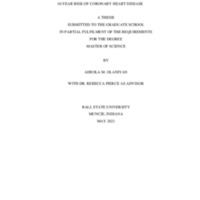Browse Exhibits (2 total)
Adeola Olaniyan | A Comparison of Machine Learning Techniques in Predicting 10-Year Risk of Coronary Heart Disease

This study uses different supervised machine learning techniques to build predictive models to predict the 10-year risk of coronary heart disease. It also compares, identifies, and selects the model with the least test error rate and the highest prediction accuracy.
Faculty Mentor: Dr. Rebecca Pierce
Department of Mathematical Sciences
Graduate
Eric Wilken | The Impact of Grant Funding on Economic Growth in Ohio: A Spatial Approach
Economic growth is often not distributed uniformly across a country or state. This provides obligation to governments to provide assistance, such as grants, to reduce economic inequality between subregions. This thesis investigates how the allocation of Ohio state grant funding impacts economic development between counties. Data were retrieved from archival data sets available between the years 2010 through 2014. The data were analyzed to consider the spatial interaction between counties as the economic activity within cities can impact the economic activity in surrounding rural areas (Henry & Drabenstott, 1996). First, an OLS regression was conducted for each year of data and analyzed to determine if spatial autocorrelation was present. Then, spatial effects were captured by conducting regressions utilizing the spatial error model, the spatial lag model, and the spatial Durbin model. The spatial models and OLS model were compared using their AIC and BIC values. The results suggest spatial regression was not preferred to OLS in modeling the impact of grant funding, in the years 2010 through 2014. Additionally, according to our model, grant funding over the 5-year period had a small and statistically non-significant impact on overall economic activity in Ohio. However, the results also indicate spatial regression will likely continue to become more important in the analysis of grant funding due to both the theoretical implications and the presence of growing spatial economic inequality. This study opens several avenues for future research such as the substitution of the one-year and 5-year growth rates of real GDP per capita for the dependent variable and investigating the trend of spatial autocorrelation in years after 2014.
Faculty Mentor: Dr. Rebecca Pierce
Department of Mathematical Sciences
Graduate
